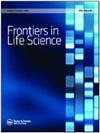An in silico guided identification of nAChR agonists from Withania somnifera
Q1 Biochemistry, Genetics and Molecular Biology
引用次数: 16
Abstract
ABSTRACT In Indian traditional practice of medicines, numerous plants have been used against various neurodegenerative disorders like Alzheimer's disease (AD). Withania somnifera (Ashwagandha in Sanskrit) is one of the medicinal plants exhibiting broad spectrum activity against various diseases. Due to its ability to improve cognitive functions, aswagandha extracts are used in various memory supplements. In the present study, the pharmacological activity of various bioactive compounds of aswagandha has been studied with respect to AD. The blood brain barrier penetrability and central nervous system (CNS) activity of these bioactive compounds were predicted using in silico tools. The predicted pharmacological properties and structure activity relationship focuses that the compounds such as anaferine, anahygrine, cuscohygrine and isopelletierine can be CNS active and neuronal nicotinic acetylcholine receptor (nAChR) agonists. In order to investigate the structure activity relationship results, molecular modeling studies has been carried out with promising ligands against nAChR. It is a known fact that the agonists of nAChRs are capable to improve communication between neurons and hence these compounds may be useful as lead compounds for the development of drugs against neurodegenerative disorders. This study also indirectly focuses how ayurvedic formulations (those containing aswagandha) are effective against neurodegenerative disorders.在计算机引导下鉴定酒藤nAChR激动剂
在印度传统的药物实践中,许多植物被用来治疗各种神经退行性疾病,如阿尔茨海默病(AD)。Withania somnifera(梵语Ashwagandha)是一种对多种疾病具有广谱活性的药用植物。由于其改善认知功能的能力,aswagandha提取物被用于各种记忆补充剂中。在本研究中,研究了aswagandha中各种生物活性化合物对AD的药理活性。利用硅工具预测了这些生物活性化合物的血脑屏障穿透性和中枢神经系统活性。预测的药理学性质和构效关系主要集中在茴香碱、反碱碱、茴香碱和异碱碱等化合物可作为中枢神经系统活性和神经元烟碱乙酰胆碱受体(nAChR)激动剂。为了研究nAChR的构效关系结果,研究人员对有前景的配体进行了分子模拟研究。已知的事实是,nachr的激动剂能够改善神经元之间的通信,因此这些化合物可能是开发抗神经退行性疾病药物的先导化合物。这项研究也间接地关注了阿育吠陀配方(那些含有aswagandha的)如何有效地对抗神经退行性疾病。
本文章由计算机程序翻译,如有差异,请以英文原文为准。
求助全文
约1分钟内获得全文
求助全文
来源期刊

Frontiers in Life Science
MULTIDISCIPLINARY SCIENCES-
CiteScore
5.50
自引率
0.00%
发文量
0
期刊介绍:
Frontiers in Life Science publishes high quality and innovative research at the frontier of biology with an emphasis on interdisciplinary research. We particularly encourage manuscripts that lie at the interface of the life sciences and either the more quantitative sciences (including chemistry, physics, mathematics, and informatics) or the social sciences (philosophy, anthropology, sociology and epistemology). We believe that these various disciplines can all contribute to biological research and provide original insights to the most recurrent questions.
 求助内容:
求助内容: 应助结果提醒方式:
应助结果提醒方式:


